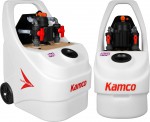Heating efficiency served up on a plate
Published: 08 June, 2017
Plate heat exchangers instantaneously generate hot water at the required temperature with flow rates measured in hundreds of litres per minute. Paul Sands, director of Stokvis Energy Systems, reports.
Contemporary commercial gas boilers bear little resemblance to either their early ancestors or even the models which dominated plant rooms beneath offices, schools, shops, offices, hospitals and other premises in the second half of the last century. Indeed they have been transformed in terms of not merely their efficiency, but their scale, reliability and safety implications.
In tandem with what have mainly been mechanical improvements in such components as burners, gas valves, pumps, flues and, of course, heat exchangers, there has also been a technological revolution in terms of the control systems, sensors and other electronics which optimise their performance throughout a long working life.
Nowadays, modern high efficiency boilers are fully-modulating and feature an automatically-controlled premix to match output to demand. In addition to extracting the maximum energy from the gas burnt, it also results in very low NOx and carbon dioxide generation. They further feature a much lower water content than conventional boilers, with a far larger heat exchanger surface area.
Modern condensing boilers are often installed in a cascade arrangement, where the duty is shared between units ramping up and down to meet demand, and when no hot water or heating output is required, they will modulate right down and turn off. They simply maintain temperature in their own primary circuits.
In fact to look around a modern plant room – especially one of the custom-built, modularised versions which can be completely pre-fitted and craned into position – is to view a clean, compact and contemporary building services solution. But what may escape the untrained eye is the even more radical change in size and form in the means by which hot water is delivered.
Demand for hot water varies greatly depending on the purpose of a property. A hotel for instance is subject to different peaks compared to offices or a school.
Where maintaining the temperature in large volumes of stored hot water requires constant energy input, which then causes constant cycling of the boilers even when insulated to a good standard, plate heat exchangers represent the ‘on demand’ alternative. They themselves feature very low water content and comprise a series of corrugated, corrosion-resistant stainless steel plates which are able to optimise the transfer of heat between the boiler’s primary circuit and the domestic hot water feed, or secondary circuit.
Plate heat exchangers therefore instantaneously generate hot water at the required temperature with flow rates measured in hundreds of litres per minute. This means that in places like large hotels and conference centres, where there may be hundreds of people deciding to take showers or baths over a very short time-span, there will still be sufficient supply. Even in industrial applications, plate heat exchangers successfully meet very high expectations for the provision of process water.
Legionella
Despite the depth of knowledge nowadays regarding the Legionella virus in water, whether for air conditioning systems or that intended to reach the taps, there remains a considerable risk to health when storing hot water. Therefore choosing instead to use plate heat exchangers to generate instantaneous hot water also negates the danger associated with storage vessels that have a temperature gradient from the bottom to the top of the vessel. Raising the temperature above 60C with a plate heat exchanger is not required as often as storage vessels. The focus on the use of alternative energy sources, and the introduction of the Renewable Heat Incentive payments, as well as previous government grant schemes, has seen the popularity of solar thermal installations soar in recent years.
On a domestic scale, the solar gain is normally delivered to a twin coil cylinder. For commercial applications, however, Stokvis would generally recommend employing the output from the collectors as a solar pre-heat arrangement, preheating the water in a vessel from where the water at whatever temperature is fed through a plate heat exchanger in order to ‘top up’ the temperature to the required level for delivery.
Essentially, whatever type of building is being considered, or the nature of the occupant’s business activity, modern modulating low water content gas boilers combined with compact modulating low water content plate heat exchangers, can meet the hot water demand reliably, safely and economically.
For further information: www.stokvisboilers.com





 KAMCO has announced two purpose built descaling pumps, the Scalebreaker C90 and C210, designed for descaling commercial and industrial boilers, chillers and plate heat exchangers. Used with the appropriate chemical, the pumps can make it simple for plant and works engineers and contractors to clean equipment with in-house staff at a time most convenient for production schedules.
KAMCO has announced two purpose built descaling pumps, the Scalebreaker C90 and C210, designed for descaling commercial and industrial boilers, chillers and plate heat exchangers. Used with the appropriate chemical, the pumps can make it simple for plant and works engineers and contractors to clean equipment with in-house staff at a time most convenient for production schedules.
